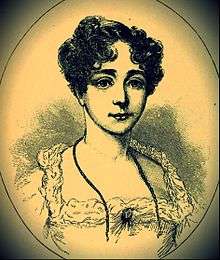Judith Montefiore
| Judith Montefiore | |
|---|---|
 | |
| Born |
Judith Barent Cohen 20 February 1784 London, England |
| Died | 24 September 1862 (aged 78) |
| Resting place | Montefiore Mausoleum, Ramsgate, Thanet District, Kent, England |
| Occupation | Linguist, musician, travel writer |
| Nationality | British |
| Spouse | |
| Relatives |
Levy Barent Cohen Lydia Diamantschleifer (parents) |
Judith, Lady Montefiore (née Barent Cohen; 20 February 1784 – 24 September 1862) was a British linguist, musician, travel writer, and philanthropist. A keen traveller, she noted the distress and suffering around her, more particularly in the "Jewish Quarters" of the towns through which she passed, and was ever ready with some plan of alleviation. Her privately printed journals, threw light upon her character, and showed her to be cultureed, imbued with a strong religious spirit, true to the teachings and observances of the Jewish faith, yet exhibiting the widest catholicity to those of other beliefs. She was quick to resent any indignity or insult that might be offered to her religion or her people.[1] Montefiore authored the first Jewish cook book written in English.[2]
Early years
Judith Barent Cohen, fourth daughter of Levy Barent Cohen and his wife, Lydia Diamantschleifer,[3][4] was born in London in 1784. The father, of Angel Court, Throgmorton Street, was a wealthy Ashkenazi or German Jew.[5]
Career
She married Sir Moses Montefiore on 10 June 1812. Marriages between Sephardim and Ashkenazim were not approved by the Portuguese Synagogue; but Moses believed that this caste prejudice was hurtful to the best interests of Judaism, and was desirous of abolishing it. There is little doubt that that marriage did more than anything else to pave the way for the present union of English Jews. They were married on 10 June 1812, and took a house in New Court, St. Swithin's Lane, next door to one Nathan Maier Rothschild, living there for 13 years.[5][6] This was likely Nathan Mayer Rothschild, founder of the Rothschild banking family of England, whom one of her sisters, Hannah (1783–1850), had married in 1806.
Her prudence and intelligence influenced all her husband's undertakings, and when he retired from business, the administration of his fortune in philanthropic endeavours was largely directed by her. Lady Montefiore accompanied her husband in all his foreign missions up to 1859, and was the beneficent genius of his memorable expeditions to the Holy Land, Damascus, Saint Petersburg, and Rome. By her linguistic abilities, she was enabled to materially assist her husband in his self-imposed tasks. During the journey to Russia, in 1846, she was indefatigable in her efforts to alleviate the misery she saw everywhere around her. The wife and daughter of the Russian governor paid her a ceremonious visit and expressed the admiration she had inspired among all classes. Her sympathies were greatly widened by travel; two journals of some of these travels were published anonymously by her. The last years of her life were spent alternately in London and Ramsgate.[6]
Later years
For some years her health had been so bad that they had spent much of their time in Europe in the hope of improving it, but she had at last become too weak to undertake the journeys, and her last days were spent in England. Only a few months prior to her decease, the couple had celebrated their golden wedding anniversary, and this period was marked by what seemed a partial restoration of her health. On 24 September 1862, after exchanging blessings with her husband, she fell into her last sleep.[1] Lady Judith died 24 September 1862.[7] At her death, Sir Moses founded in her memory the Judith Lady Montefiore College at Ramsgate.[8] [9]
References
- 1 2 Step 1885, p. 72.
- ↑ Brown, Susan, Patricia Clements, & Isobel Grundy (ed.). "Charlotte Montefiore". medusa.arts.ualberta.ca. Retrieved 5 July 2018 – via Cambridge Core Orlando Project. (Subscription required (help)).
- ↑ Taylor 1813, p. 335.
- ↑ Montefiore & Montefiore 1890, p. 349.
- 1 2 Step 1885, p. 11.
- 1 2 Singer & Adler 1912, p. 667.
- ↑ "Judith Montefiore". Jewish Women's Archive. Retrieved 12 January 2017.
- ↑ "College history". The Montefiore Endowment. Retrieved 15 December 2016.
- ↑ Singer & Adler 1912, p. 668.
Attribution




Bibliography
- Jew. Chron. 3 October 1863
- Kayserling, Die Judischen Frauen, pp. 272–275, 1308
- Loewe, L. Diaries of Sir Muses and Lady Montefiore, 1890.
- Morals, Eminent Israelites, pp. 240–312
- Wolf, Lucien. Life (of Sir Moses Montefiore), pp. 189–212